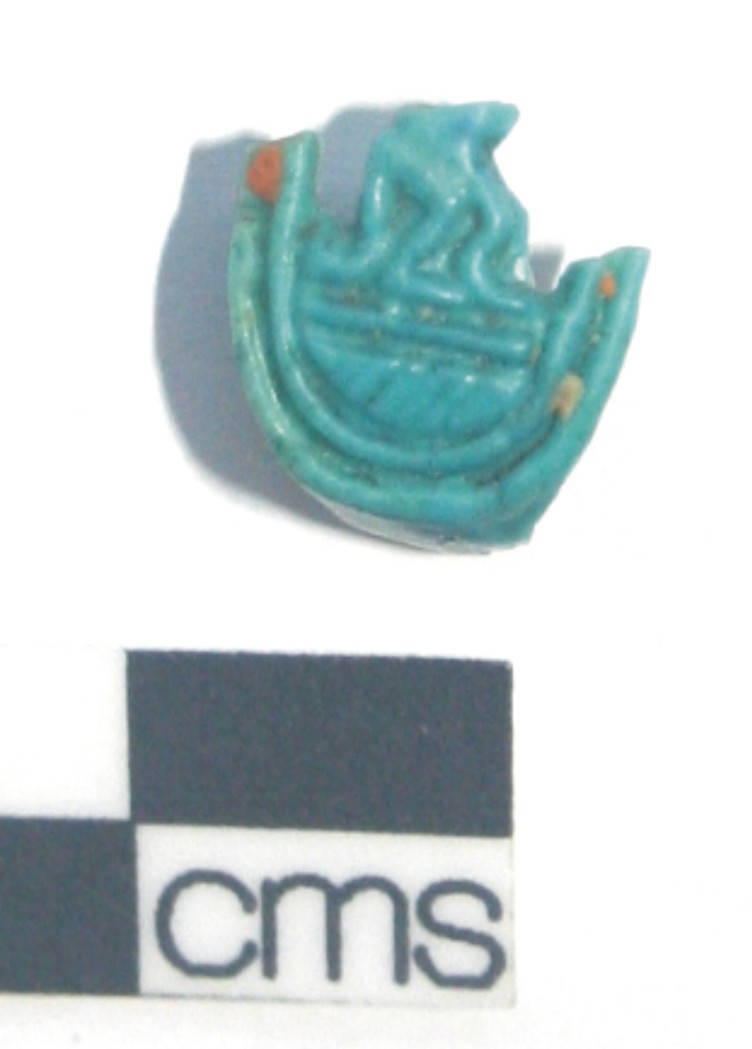W1151
 W1151
W1151
A ring bezel showing a dancing Bes.
This is a fragment of a ring bezel which comes from Amarna. It was donated to the Egypt Centre by the British Museum. This item was donated by the British Museum in 1978. With W1150a and W1155, these bezels are notable as part of the original group used to illustrate the ‘new corpus’ listed by Frankfort and Pendlebury (1933: 115-117, pl. XLIX).
W1151 is a fragment of an openwork bezel showing a dancing or striding figure in profile facing right with long tail. It is identical to the bezel illustrated in Frankfort and Pendlebury pl. XVIX.5 and XLIX .ID25 which is from T.36.15 in the North Suburbs (Frankfort and Pendlebury 1933: 84, 115 and pls. XVIX.5 and XLIX .ID25). Page 51 says of T.36.15 ‘These miserable hovels require little description. The only one with any pretension is 15, with a red-yellow-red niche in the central room.’ Boyce (1995: 358) has suggested however, that given the number of moulds for faience jewellery concentrated around areas such as T36 it is likely that this represents a manufacturing area.
The fragmentary nature of this item means it could either be a Bes deity or a monkey. For similar depictions of Bes in profile see Stevens (2006: 32, fig. 11.2.2). There are nineteen Bes ring bezels from Amarna recorded by Stevens from the excavation reports (2006: 31) and no purely monkey or baboon bezels (Stevens 2006: 60-61). Thus, while monkey amulets are known from the site (e.g. Egypt Centre’s W961p), and monkey ring bezels of unknown provenance are known (e.g. UC58198), it seems more likely that this is a Bes bezel.
Depictions of Bes deities in profile are first known in the reign of Amenhotep III and such examples commonly show him playing a drum (Andrews 1994: 40). Bes was very popular at Amarna, with over 500 examples of faience jewellery depicting him.
Bes is apotropaic, solar and particularly associated with young women and childbirth. At Amarna and Deir el-Medina he is commonly shown with Taweret (Stevens 2006: 216), thus reinforcing his fertility aspects . As is suitable for a deity associated with sexuality, Bes is often shown naked and often as a drummer, and in the Leiden bowl (AD14), mentioned above, is depicted on the lute player’s leg. The drum, in the Near East was particularly associated with female musicians (Meyers 1993). In Egypt, only the rectangular framed drum is particularly associated with women during the New Kingdom (Teeter 1993: 80), yet Bes appears to play a circular drum which is an instrument of both men and women.
Further Reading
Graves-Brown, C. 2014. A Gazelle, A Lute Player and Bes. Three Ring Bezels from Amarna, In Dodson, A. Johnston, J.J. and Monkhouse, W. (eds.) A Good Scribe and an Exceedingly Wise Man. Studies in Honour of W.J. Tait. London: Golden House, 113-126.
Frankfort, H. and Pendlebury J.D.S. 1933, The City of Akhenaten Part II, The North Suburb and the Desert Altars: The Excavations at Tell el-Amarna During the Seasons 1926-1932. London: Egypt Exploration Society.
Friedman, F.D. ed. 1998. Gifts of the Nile Ancient Egyptian Faience. London: Thames and Hudson.
Meyers, C. 1993. ‘The Drum-Dance-Song Ensemble: women’s Performance in Biblical Israel.’ In Rediscovering the Muses, Women’s Musical Traditions edited by K. Marshall. Boston: Northeastern University Press, 49-67.
Reeves, N. 1985. ‘A lute player of the Amarna Period’ GM 87, 79-82.
Stevens, A., 2006. Private Religion at Amarna. The material evidence. BAR International Series 1587. Oxford: Archeopress.
Teeter, E. 1993. Female Musicians in Pharaonic Egypt In Marshall, K.(ed.) Rediscovering the Muses, Women’s Musical Traditions. Boston: Northeastern University Press, 68-91.
Other Amarna Objects in the Egypt Centre